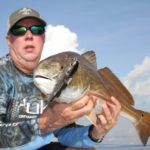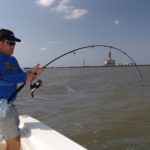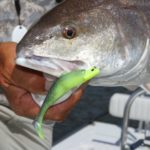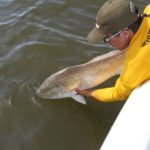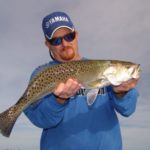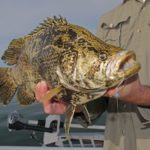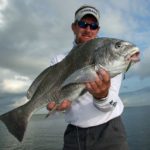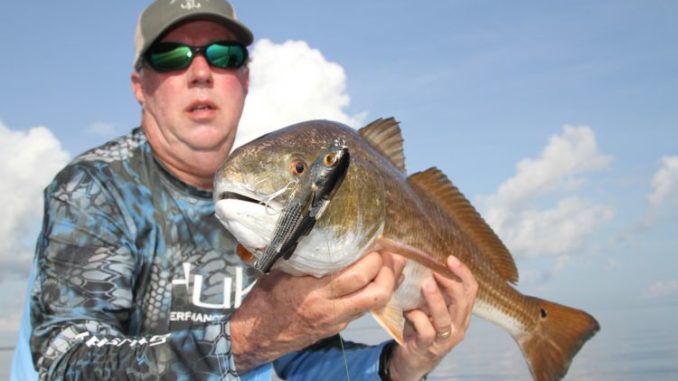
There are few gimmes in fishing, but Southwest Pass at the mouth of the Mississippi River is one of them. So make the haul from Venice and catch redfish until your arms are sore using these tips.
About 20 years ago, former Venice Marina owner Dave Ballay told me, “If someone held a gun to my head and said I had to catch a fish, 365 days a year, I’d go to Southwest Pass.”
Pretty strong endorsement, and not one with which many would argue. This place is a fish magnet.
The longest and deepest of the Delta portals, Southwest Pass might be best known for its commercial shipping lane, but anglers know it as the closest thing to a guaranteed bent rod as you’ll find.
Consider the attraction points:
• Depth: The U.S. Army Corps of Engineers maintains a 45-foot shipping channel.
• Salinity: Extending the farthest into the Gulf of all the Mississippi River passes, Southwest Pass provides the optimal environment for marine species.
• Structure: Several miles of rock jetties plus wing dams built inside the rocky mounds to minimize siltation harbor lots of forage for a variety of predators.
“It’s just a tremendous amount of structure sticking out into the Gulf of Mexico,” said Ballay’s son, Brent, who guides out of Venice Marina.
• Wind Break: “The good thing about Southwest Pass is that if you have an east wind, you (can) fish the west side; if you have a west wind, you (can) fish the east side,” Brent Ballay said. “A south wind’s a bit of a nasty mess, but otherwise you can usually find a calm place to fish.”
• Food funnel: Ballay also pointed to the rich bounty of shrimp, shad and other forage flowing through the big pass as a major fish attractor.
• Bonus fishing: We’ll focus on the inshore stuff, but proximity to deep offshore waters offers options for those looking to add a little snapper or tuna action to their pass program.
On a calm day, anglers launching at Venice and running out of Tiger Pass can make the end of Southwest Pass in about 20 minutes. When windy conditions make the Gulf choppy, running downriver takes about 35 minutes.
“There’s a lot of productive water in the bay system that we navigate, and we want to see the conditions in those bays, as well as any obvious signs of fish that we might be able to pursue prior to getting to the end of the jetty,” Paradise Plus Lodge’s Capt. Anthony Randazzo said.
But however you get there, Southwest Pass typically rewards anglers with lots of fishing action.
Here’s a look at some of the highlights:
Bull fight
What to look for: With big redfish the premier Southwest Pass target, Randazzo suggested finding areas where the water changes speed from fast current to slow and vice versa.
This is generally where you’ll find baitfish stacking.
Also, surface activity such as bait schools or predators breaking water indicates productive spots. Surface slicks formed when predators munch on those bait schools offer yet another sign.
“On the flip side of all that, the general rule of thumb is that on a falling tide you want to be fishing inside the jetties or at the end of the jetties, and on a rising tide you want to be fishing on the outside of the jetties,” Randazzo noted. “When that tide comes out, all the saltwater forage comes out, and the fish just sit there in a position to ambush.
“The rising tide brings plenty of bait and plenty of good, clean saltwater underneath the fresh water right up to the edge of the jetties.”
Baits: The good thing about bull reds is that they’re just not fancy folks: A 3/8- to ½-ounce jig with a Berkley Gulp, an Egret Baits Bayou Chub or Sand Eel Wedge Tail will find plenty of takers.
Ballay prefers a fish-finder rig comprised of a 1- to 2-ounce egg sinker, a 2-foot leader and 5/0 hook with a dead shrimp or pogie. The latter, he hooks through the nose so it doesn’t spin.
Ballay gets as close as possible to the end of the jetty, anchors and casts to the rocks — or he drops straight down when he spots the fish on his electronics.
Birds near the surface can indicate bulls feeding, but he’s constantly watching for the crimson convoy.
“The reds will get schooled up, and travel up and down the jetty,” Ballay said. “You’ll see them with their heads and backs out of the water.
“If you spot a school, you want to stay on top of them; they’re not boat shy.”
The it’s just a matter of putting bait in the water.
“The more baits you get into the water, the more they’re eating,” Ballay said.
And don’t hesitate to let loose with the topwater plugs. Guides like Capt. Mike Frennette find Southwest Pass bulls fond of big walking and popping baits.
Other options include deep-diving crankbaits, big lipless cranks and 3/8-ounce single Colorado blade spinnerbaits. With the latter, Randazzo suggests a slow fall that helicopters down just fast enough to keep the blades moving.
East Bay Boogie
What to look for: Ballay said Joseph’s Bayou on the east side of the Southwest Pass jetties offers a good mix of ponds and run-outs nearly all the way down the pass.
Here, you’ll find a good mix of reds, largemouth bass and flounder in the 3- to 5-pound range.
“You gotta hit it on the falling tide when the water is pulling out of the drains,” Ballay said.
Baits: Spoons and spinnerbaits tempt the reds and bass, while flounder seekers slow-crawl 3/8-ounce jigs with purple-and-chartreuse Chubs with pieces of cut shrimp.
Spill the beans
What to look for: Ballay pointed to Spillways 1 and 2 on the west side as speckled trout sweet spots — particularly in the fall.
The designed gaps in the jetty create major outfall points, with drop-offs where fish congregate.
Baits: Ballay keeps it simple, with twin jig rigs cast upcurrent.
Expecting to find the most-aggressive trout feeding right in the current, he walks his bait down the ledges and looks for fast bites in the swift water.
Other options
• Transitional Trout: Randazzo said late summer always sees a big run of trout around Southwest Pass when the fish transition from offshore to inshore.
He said these fish will roam to the closest rigs near the jetty, and back and forth to follow the tide and the bait. During the warmer months, Randazzo said this is primarily a live shrimp or live pogie bite, but jigs come into play as fall approaches.
• Trippin’ Out: Random tripletail could turn up about anytime in the Gulf of Mexico, but every October Randazzo looks for a phenomenal tripletail bite around the Southwest Pass jetties and its wing dams.
Remember that tripletail rarely cruise, circle or meander like just about any other predator fish you’re used to looking at. Theirs is a hang-and-wait strategy that involves unusual, often lateral postures that imitate pieces of floating trash or debris.
When a baitfish or shrimp drifts close, the seemingly inanimate object springs to life and gobbles the meal.
That being said, patiently sight-fishing pass structure with 3/8-ounce jigs with purple-and-chartreuse Bayou Chubs tipped with shrimp usually yields several targets.
If trips play hard to get, try corking shrimp right in front of the fish.
• Fast Movers: Troll Magnum Rapalas along the jetties and you’ll likely meet some of the king and Spanish mackerel patrolling Southwest Pass.
• Drum Beat: For the black drum and smaller reds that graze around the jetties, Ballay suggested looking for breaks and flow-throughs in the jetty rocks, which allow water — and food — to wash over.
Light jigs with purple-and-chartreuse cocahoe minnows, spinnerbaits or fish-finders with shrimp are effective at getting bites.
Clearly, diversity abounds, but don’t over-think this place. Strategy and preparation certainly help, but when asked for his top tip for Southwest Pass success, Ballay nailed the perennial preference.
“Just fish it,” he said.
